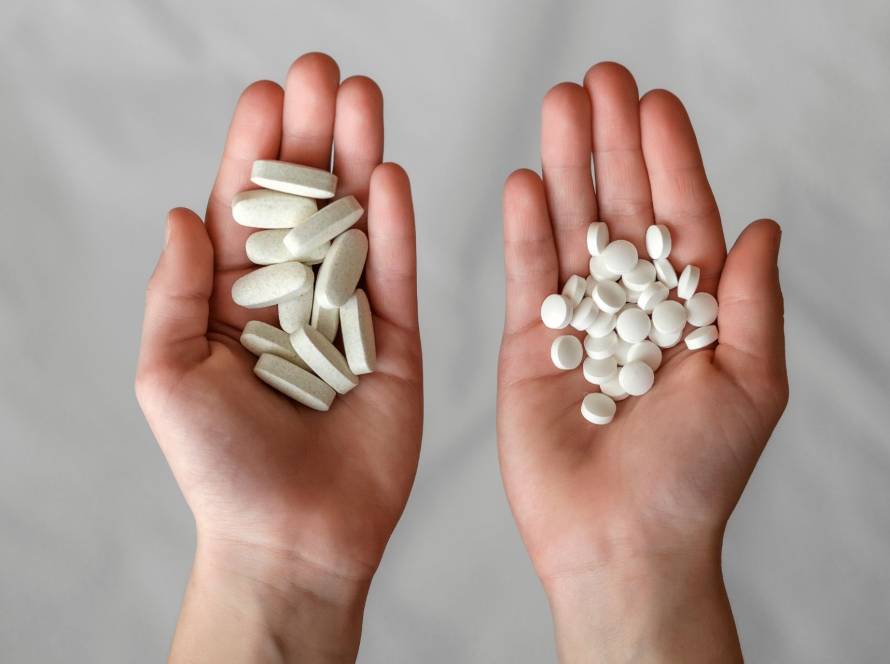Niacin and niacinamide might sound similar, but these two forms of vitamin B3 work differently in our body. People often mix up nicotinamide (niacinamide) and nicotinic acid (niacin) and each affects our health in its own way.
The difference between these compounds matters because of their unique effects. Niacin substantially changes cholesterol levels. Niacinamide works differently, it helps maintain healthy skin by boosting epidermal barrier function and ceramide production.
This piece will get into the key differences between these two vitamin B3 forms, helping to choose the right form that matches with each health needs.
The science behind vitamin B3
Vitamin B3 is the life blood of cellular metabolism and plays a vital role in over 400 enzymatic reactions throughout our body. B3s molecular structure exists in several forms that create niacinamide coenzymes, especially NAD+ and NADP+.
Molecular structure and function
The NAD(P)(H) pool consists of functional cofactors from vitamin B3 that cover NAD+, NADP+ and their reduced forms (NAD(P)H). These molecules are essential components in all bioenergetic pathways and support both anabolic and catabolic processes. NAD+ works at the intersection of cell metabolism and signaling, which makes it a significant target for nutritional interventions.
These coenzymes serve different functions:
- NAD supports energyproducing reactions and breaks down carbohydrates, fats, proteins and alcohol;
- NADP aids biosynthetic processes, including fatty acid synthesis, steroid production and antioxidant system regeneration.
How your body processes B3
Your body processes vitamin B3 through multiple pathways to create NAD+. The main routes include:
- The Preiss-Handler pathway: changes niacin to NAD+ through three enzymatic steps;
- The Salvage pathway: creates nicotinamide mononucleotide (NMN) from niacinamide;
- The Kynurenine pathway: changes tryptophan into NAD+ through multiple intermediates.
Your body maintains precise control over these cofactors. NAD stays largely in its oxidized state (NAD+) for catabolic reactions, while NADP remains mostly reduced (NADPH) to support reductive cellular processes. B3s water soluble nature means your body can’t store it, so you need daily intake through diet or supplements.
B3s cellular processing involves extensive first pass metabolism, which leads to varying bloodstream concentrations. This metabolic pathway creates various intermediates, including niacin mononucleotide (NAMN) and nicotinamide mononucleotide (NMN), before finally producing NAD+. This complex processing system shows B3 metabolisms intricate nature and its fundamental role in maintaining cellular health.
Niacin vs niacinamide: key differences
Niacin and niacinamide may share similar names, but they have unique molecular structures and biological functions that make them quite different from each other. These differences play a vital role in making informed decisions about supplements and health optimization.
Chemical structure comparison
Both compounds are part of the vitamin B3 family, yet their molecular arrangements are different. Nicotinic acid, which scientists call niacin (pyridine-3-carboxylic acid), has a carboxylic acid group. On the other hand, niacinamide (pyridine-3-carboxamide) has an amide group instead of the acid group. This small structural change creates very different effects in the body.
We can see this difference in how they convert to NAD+. Niacin needs three enzymatic steps through the Preiss-Handler pathway, while niacinamide only needs two. When niacin gets an amide group and becomes niacinamide, it can’t reduce cholesterol anymore.
Absorption and metabolism
Studies show that body handles these compounds differently, processing niacin with a half life of 0.9 hours, while niacinamide stays active for 4.3 hours. The body removes about 69.5% of a niacin dose through urine.
These compounds interact differently with receptors in the body. Niacinamide doesn’t bind to the same receptors as niacin, which explains why it can’t modify lipids. This specific receptor binding also explains why you don’t get the typical “flush” response with niacinamide that you get with niacin.
Niacinamides role in longevity
Scientific research has revealed niacinamides vital role in cellular longevity through its effects on NAD+ metabolism and cellular repair mechanisms. This vitamin B3 form acts as a key precursor for coenzymes that support cell health and longevity.
NAD+ production pathway
Niacinamide acts as a key precursor for nicotinamide adenine dinucleotide (NAD+), a coenzyme needed for ATP production. Cells convert niacinamide through specific enzyme pathways to create NAD+ and NADP+. These molecules then become key parts of the cells energy production and DNA repair processes.
NAD+ levels naturally drop as we age. This decline affects many metabolic processes, which makes NAD+ replacement through niacinamide supplements vital for cell health. Studies show that niacinamide effectively raises NAD+ levels inside cells to support key metabolic functions.
Cellular repair mechanisms
Niacinamide affects cellular repair through several pathways:
- DNA repair improvement through PARP-1 activation;
- Protection from UV radiation damage;
- Lower oxidative stress through NAD+.
The molecule helps repair DNA by acting as a substrate for PARP-1, an enzyme that finds and fixes DNA damage. This process becomes vital as cells age and face more genomic stress.
Impact on aging
Research shows niacinamides effects on aging processes:
- Cellular energy production: niacinamide maintains proper NAD+ levels needed for mitochondrial function and energy production;
- Oxidative stress management: it helps antioxidant systems through NADPH production;
- Gene expression regulation: niacinamide affects sirtuin activity, which influences aging related processes.
Studies indicate that niacinamide supplements can extend lifespan in various organisms by keeping NAD+ at good levels. Research reveals that niacinamide can restore older cells gene expression to match younger cells levels.
Niacinamide does more than just maintain cells. It helps cells respond to stress and keeps genomic stability. These mechanisms support cell health and might extend cell lifespan.
Skin health
Niacinamide shines when it comes to skin benefits. Clinical studies show it can:
- Make the skin’s lipid barrier work better;
- Reduce redness and inflammation;
- Balance oil production.
A 12 week study with 5% niacinamide showed great results:
- Fine lines improved;
- Skin tone clarity got better;
- Skin radiance increased.
Niacins therapeutic effects
Niacin has shown promise as a candidate to improve cardiovascular health, which led to the largest longitudinal study and clinical trials. Recent studies show this vitamin B3 forms benefits and limitations.
Cardiovascular benefits
The original research showed an optimistic outlook of niacins heart protective properties. Clinical data shows niacin can decrease low density lipoprotein (LDL) cholesterol by 15-25% and increase high density lipoprotein (HDL) cholesterol by 15-25%. These improvements in blood lipid profiles suggested what it all means for heart health.
Modern research offers a more balanced perspective. A complete analysis of 23 studies found that niacin therapy did not reduce:
- Overall mortality rates;
- Cardiovascular mortality;
- Number of heart attacks;
- Stroke incidents.
Metabolic improvements
Niacin shows promising metabolic benefits beyond its effects on heart health. Recent research shows that dietary niacin intake relates to better body composition. The benefits include:
- Higher grip strength;
- Increased total lean mass;
- Reduced total body fat;
- Lower trunk fat.
Niacin also shows potential in glucose regulation. Studies show that dietary niacin intake reduces by a lot:
- HOMA-IR levels;
- Fasting blood glucose in non diabetic individuals;
- Fasting insulin levels.
High dose niacin therapy needs careful thought. Studies show that about 18% of users stop treatment due to side effects. Common reactions include:
- Skin flushing (up to 71%);
- Headache (8%);
- Pruritus (6%);
- Gastrointestinal symptoms (10%).
Niacins safety and dosage guidelines
Knowing proper dosage guidelines and identifying potential risks will give you safe supplementation with vitamin B3. Following these recommendations minimizes adverse effects and maximizes health benefits.
Recommended daily intake
The recommended daily allowance varies based on age and gender:
- Adult men: 16 mg daily;
- Adult women: 14 mg daily;
- Pregnant women: 18 mg daily;
- Breastfeeding women: 17 mg daily.
Children need more as they grow older. Requirements range from 2 mg for infants to 16 mg for teenage boys. These amounts usually come from dietary sources and fortified foods.
Maximum safe limits
Upper intake limits from supplements differ by age group:
- Children (1-3 years): 10 mg;
- Children (4-8 years): 15 mg;
- Children (9-13 years): 20 mg;
- Teens (14-18 years): 30 mg;
- Adults (19+ years): 35 mg.
Risk factors to think over
Some health conditions need extra caution with vitamin B3 supplementation:
- Liver disease: high doses may worsen liver function;
- Diabetes: both forms can affect blood sugar control;
- Kidney disease: risk of low platelet levels increases in dialysis patients;
- Gallbladder issues: supplementation might worsen existing conditions.
Niacinamide is easier to tolerate and works better for skin health and cellular repair. Niacin needs careful medical oversight because of its potential side effects.
Both forms add value to our well being in their own way, but their unique properties make them right for different uses. This knowledge helps us make smart choices about vitamin B3 supplements to support our path to better health and longevity.
Learn more about:


